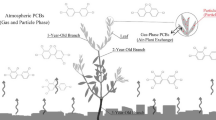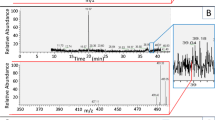Abstract
Olive tree leaf samples were collected to investigate their possible use for biomonitoring of lipophilic toxic substances. The samples were analyzed for 28 polychlorinated biphenyls (PCB) congeners. Twelve congeners were detected in the samples. PCB-60, 77, 81, 89, 105, 114, and 153 were the most frequently detected congeners ranging from 32 % for PCB-52 to 97 % for PCB-81. Σ12PCBs concentration varied from below detection limit to 248 ng/g wet weight in the sampling area, while the mean congener concentrations ranged from 0.06 ng/g (PCB-128 + 167) to 64.2 ng/g wet weight (PCB-60). Constructed concentration maps showed that olive tree leaves can be employed for the estimation of spatial distrubution of these congeners.

Similar content being viewed by others
References
ATSDR (2000) Toxicological profile for polychlorinated biphenyls (PCBs), US Department of Health and Human Services. Agency for Toxic Substances and Disease Registry, Atlanta
Blais JM, Froese KL, Kimpe LE, Muir DCG, Backus S, Comba M, Schindler DW (2003) Assessment and characterization of polychlorinated biphenyls near a hazardous waste incinerator: analysis of vegetation, snow, and sediments. Environ Toxicol Chem 22:126–133
Chen J, Zhao H, Gao L, Henkelmann B, Schramm KW (2006) Atmospheric PCDD/F and PCB levels implicated by pine (Cedrus deodara) needles at Dalian, China. Environ Pollut 144:510–515
Elik A, Akçay M, Sökmen M (2000) Ultrasonic leaching of bio-collectors for heavy metal analysis. Int J Environ Anal Chem 77:133–145
Eriksson G, Jensen S, Kylin H, Strachan W (1989) The pine needle as a monitor of atmospheric pollution. Nature 341:42–44
Falandysz J, Orlikowska A, Jarzyńska G, Bochentin I, Wyrzykowska B, Drewnowska M, Hanari N, Horii Y, Yamashita N (2012) Levels and sources of planar and non-planar PCBs in pine needles across Poland. J Environ Sci Health A 47:688–703
Fernández JE, Moreno F (1999) Water use by the olive tree. J Crop Prod 2:101–162
Holoubek I, Kořínek P, Šeda Z, Schneiderová E, Holoubková I, Pacl A, Tříska J, Cudlín P, Čáslavský J (2000) The use of mosses and pine needles to detect persistent organic pollutants at local and regional scales. Environ Pollut 109:283–292
Klánová J, Čupr P, Baráková D, Šeda Z, Anděl P, Holoubek I (2009) Can pine needles indicate trends in the air pollution levels at remote sites? Environ Pollut 157:3248–3254
Kodavanti PRS, Kannan N, Yamashita N, Derr-Yellin EC, Ward TR, Burgin DE, Tilson HA, Birnbaum LS (2001) Differential effects of two lots of Aroclor 1254: congener-specific analysis and neurochemical end points. Environ Health Perspect 109:1153–1161
Kožul D, Romanić S (2008) Distribution of organochlorine compounds in pine needles collected in Zagreb. Bull Environ Contam Toxicol 81:339–342
Leon JM, Bukovac MJ (1978) Cuticle development and surface morphology of olive leaves with reference to penetration of foliar-applied chemicals. J Am Soc Hortic Sci 103:465–472
Mast MA, Alvarez DA, Zaugg SD (2012) Deposition and accumulation of airborne organic contaminants in Yosemite National Park, California. Environ Toxicol Chem 31:524–533
Müller JF, Hawker DW, McLachlan MS, Connell DW (2001) PAHs, PCDD/Fs, PCBs and HCB in leaves from Brisbane, Australia. Chemosphere 43:507–515
Romanić SH, Klinčić D (2012) Organochlorine compounds in pine needles from Croatia. Bull Environ Contam Toxicol 88:838–841
Sabljic A, Guesten H, Schoenherr J, Riederer M (1990) Modeling plant uptake of airborne organic chemicals. 1. Plant cuticle/water partitioning and molecular connectivity. Environ Sci Technol 24:1321–1326
Schulz H, Popp P, Huhn G, Stärk HJ, Schüürmann G (1999) Biomonitoring of airborne inorganic and organic pollutants by means of pine tree barks. I. Temporal and spatial variations. Sci Total Environ 232:49–58
Schuster JK, Gioia R, Sweetman AJ, Jones KC (2010) Temporal trends and controlling factors for polychlorinated biphenyls in the UK atmosphere (1991–2008). Environ Sci Technol 44:8068–8074
Tasdemir Y, Odabasi M, Vardar N, Sofuoglu A, Murphy TJ, Holsen TM (2004) Dry deposition fluxes and velocities of polychlorinated biphenyls (PCBs) associated with particles. Atmos Environ 38:2447–2456
Tato L, Tremolada P, Ballabio C, Guazzoni N, Parolini M, Caccianiga M, Binelli A (2011) Seasonal and spatial variability of polychlorinated biphenyls (PCBs) in vegetation and cow milk from a high altitude pasture in the Italian Alps. Environ Pollut 159:2656–2664
Turan D, Kocahakimoglu C, Kavcar P, Gaygisiz H, Atatanir L, Turgut C, Sofuoglu SC (2011) The use of olive tree (Olea europaea L.) leaves as a bioindicator for environmental pollution in the Province of Aydın, Turkey. Environ Sci Pollut Res 18:355–364
Wyrzykowska B, Bochentin I, Hanari N, Orlikowska A, Falandysz J, Yuichi H, Yamashita N (2006) Source determination of highly chlorinated biphenyl isomers in pine needles – comparison to several PCB preparations. Environ Pollut 143:46–59
Wyrzykowska B, Hanari N, Orlikowska A, Bochentin I, Rostkowski P, Falandysz J, Taniyasu S, Horii Y, Jiang Q, Yamashita N (2007) Polychlorinated biphenyls and -naphthalenes in pine needles and soil from Poland—concentrations and patterns in view of long-term environmental monitoring. Chemosphere 67:1877–1886
Xu D, Deng L, Chai Z, Mao X (2004) Organohalogenated compounds in pine needles from Beijing City, China. Chemosphere 57:1343–1353
Acknowledgments
Olive leaves were collected in a research project supported by the Scientific and Technical Research Council of Turkey (grant no. 107O170).
Conflict of interest
The authors declare that there are no conflicts of interest.
Author information
Authors and Affiliations
Corresponding author
Additional information
Responsible editor: Leif Kronberg
Rights and permissions
About this article
Cite this article
Sofuoglu, S.C., Yayla, B., Kavcar, P. et al. Olive tree, Olea europaea L., leaves as a bioindicator of atmospheric PCB contamination. Environ Sci Pollut Res 20, 6178–6183 (2013). https://doi.org/10.1007/s11356-013-1640-y
Received:
Accepted:
Published:
Issue Date:
DOI: https://doi.org/10.1007/s11356-013-1640-y




